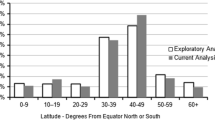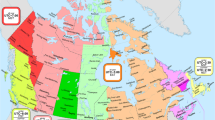Abstract
Large disruptions of chronobiological rhythms are documented as destabilizing individuals with bipolar disorder; however, the impact of small phase altering events is unclear. Australian suicide data from 1971 to 2001 were assessed to determine the impact on the number of suicides of a 1-h time shift due to daylight saving. The results confirm that male suicide rates rise in the weeks following the commencement of daylight saving, compared to the weeks following the return to eastern standard time and for the rest of the year. After adjusting for the season, prior to 1986 suicide rates in the weeks following the end of daylight saving remained significantly increased compared to the rest of autumn. This study suggests that small changes in chronobiological rhythms are potentially destabilizing in vulnerable individuals.
Similar content being viewed by others
References
Healy D, Waterhouse JM. The circadian system and the therapeutics of the affective disorders. Pharmacol. Ther. 1995; 65: 241–63.
Brown GM. Neuroendocrine probes as biological markers of affective disorders: new directions. Can. J. Psychiatry 1989; 34: 819–23.
McIntyre IM, Armstrong SM, Norman TR, Burrows GD. Treatment of seasonal affective disorder with light: preliminary Australian experience. Aust. N. Z. J. Psychiatry 1989; 23: 369–72.
van Houwelingen CAJ, Beersma DGM. Seasonal changes in 24-hour patterns of suicide rates: a study on train suicides in the Netherlands. J. Affect. Disord. 2001; 66: 215–23.
Parker G, Walter S. Seasonal variation in depressive disorders and suicidal deaths in New South Wales. Br. J. Psychiatry 1982; 140: 626–32.
Wehr TA, Sack DA, Rosenthal NE. Sleep reduction as the final common pathway in the genesis of mania. Am. J. Psychiatry 1987; 144: 201–4.
Wehr TA. Effects of sleep and wakefulness in depression and mania. In: Montplaisir J, Godbout R, eds. Sleep and Biological Rhythms. London: Oxford University Press, 1990; 42–86.
Leibenluft E, Suppes T. Treating bipolar illness: focus on treatment algorithms and management of the sleep-wake cycle. Am. J. Psychiatry 1999; 156: 1976–81.
Wirz-Justice A, Quinto C, Cagochen C, Werth E, Hock C. A rapid-cycling bipolar patient treated with long nights, bedrest and light. Biol. Psychiatry 1999; 45: 1075–7.
Hakkarainen R, Johansson C, Kieseppa T et al. Seasonal changes, sleep length and circadian preference among twins with bipolar disorder. BMC Psychiatry 2003; 3: 1–7.
Nathan PJ, Burrows GD, Norman TR. Melatonin sensitivity to dim white light in affective disorders. Neuropsychopharmacology 1999; 21: 408–13.
Hallam KT, Olver JS, Norman TR. Melatonin sensitivity to light in monozygotic twins discordant for bipolar I disorder. Aust. N. Z. J. Psychiatry 2005; 39: 947.
Frank E, Swartz A, Kupfer DJ. Interpersonal and social rhythm therapy: managing the chaos of bipolar disorder. Soc. Biol. Psychiatry 2000; 48: 593–604.
D’Mello DA, McNeil JA, Msibi B. Seasons and bipolar disorder. Ann. Clin. Psychiatry 1995; 7: 11–18.
Nathan PJ, Wyndham EL, Burrows GD, Norman TR. The effect of gender on the melatonin suppression by light: a dose-response relationship. J. Neural Transm. 2000; 107: 271–9.
Nathan PJ, Burrows GD, Norman TR. The effect of dim light on suppression of nocturnal melatonin in healthy women and men. J. Neural Transm. 1997; 104: 643–8.
Brun J, Claustrat B, David M. Urinary melatonin, LH, oestradiol, progesterone excretion during the menstrual cycle or in women taking oral contraceptives. Acta Endocrinol. 1987; 116: 145–9.
Kostoglou-Athanassiou I, Athanassiou P, Treacher DF, Wheeler MJ, Forsling ML. Neurohypophysial hormone and melatonin secretion over the natural and suppressed menstrual cycle in premenopausal women. Clin. Endocrinol. (Oxf.) 1998; 49: 209–16.
Wetterberg L, Arendt J, Paunier L, Sizonenko PC, Donselaar W, Heyden T. Human serum melatonin changes during the menstrual cycle. J. Clin. Endocrinol. Metab. 1976; 42: 185–8.
Wright KP Jr, Badia P. Effects of menstrual cycle phase and oral contraceptives on alertness, cognitive performance, and circadian rhythms during sleep deprivation. Behav. Brain Res. 1999; 103: 185–94.
Berk M, Dodd S, Henry M. The effect of macroeconomic variables on suicide. Psychol. Med. 2006; 36: 181–9.
Goodwin FK, Jamison KR. Manic-Depressive Illness. New York, NY: Oxford University Press, 1990.
Young DM. Psychiatric morbidity in travelers to Honolulu. Hawaii Compr. Psychiatry 1995; 36: 224–8.
Frank E, Kupfer DJ, Thase ME et al. Two-year outcomes for interpersonal and social rhythm therapy in individuals with bipolar I disorder. Arch. Gen. Psychiatry 2005; 62: 996–1004.
Author information
Authors and Affiliations
Corresponding author
Rights and permissions
About this article
Cite this article
Berk, M., Dodd, S., Hallam, K. et al. Small shifts in diurnal rhythms are associated with an increase in suicide: The effect of daylight saving. Sleep Biol. Rhythms 6, 22–25 (2008). https://doi.org/10.1111/j.1479-8425.2007.00331.x
Received:
Accepted:
Published:
Issue Date:
DOI: https://doi.org/10.1111/j.1479-8425.2007.00331.x




